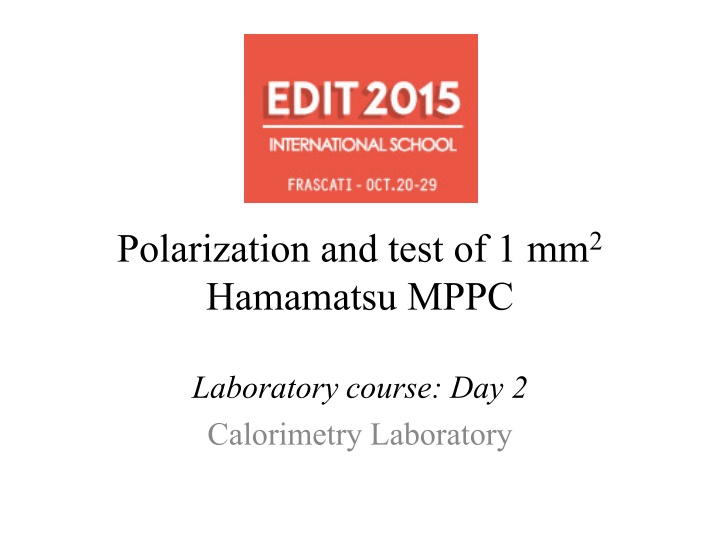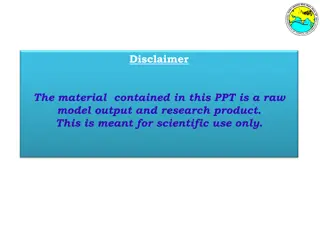
Understanding MPPC in Calorimetry Laboratory Course
Explore the practical aspects of polarization and testing of 1 mm2 Hamamatsu MPPC in a laboratory setting, focusing on building circuits, measuring responses to light sources, and studying linearity and gain. Delve into the operation of multi-pixel photon counters and their application in Geiger mode photodiodes. Discover the significance of quenching resistors in halting avalanche multiplication and grasp the basic operation of MPPCs through pixel arrays.
Download Presentation

Please find below an Image/Link to download the presentation.
The content on the website is provided AS IS for your information and personal use only. It may not be sold, licensed, or shared on other websites without obtaining consent from the author. If you encounter any issues during the download, it is possible that the publisher has removed the file from their server.
You are allowed to download the files provided on this website for personal or commercial use, subject to the condition that they are used lawfully. All files are the property of their respective owners.
The content on the website is provided AS IS for your information and personal use only. It may not be sold, licensed, or shared on other websites without obtaining consent from the author.
E N D
Presentation Transcript
Polarization and test of 1 mm2 Hamamatsu MPPC Laboratory course: Day 2 Calorimetry Laboratory
Experience Description The 6 students will be separated in three groups. The experience is composed by three parts: Build a polarization circuit for a 1 mm2Hamamatsu MPPC; Measure the response of the MPPC to a blue led/laser changing the light on the detector with a graduated polaroid; Study the MPPC linearity and the gain. 18 March 2025 Calorimetry laboratory 2
APD 18 March 2025 Calorimetry laboratory 3
I-V curve A photodiode working in Geiger mode is polarized with a reverse bias voltage greater than the Breakdown. In this way, there is a very high electric field in the depletion region, such that one photon interacting will produce the avalanche. 18 March 2025 Calorimetry laboratory 4
MPPC The MPPC (multi-pixel photon counter) is one of the devices called silicon photomultipliers (SiPM). It is a photon-counting device using multiple APD (avalanche photodiode) pixels operating in Geiger mode; When the reverse voltage applied to an APD is set higher than the breakdown voltage, the electric field in the APD becomes high enough to cause a discharge (Geiger discharge) even by input of very weak light. The condition where an APD operates at this voltage level is called Geiger mode; The Geiger mode allows obtaining a large output by way of the discharge even when detecting a single photon. Once the Geiger discharge begins, it continues as long as the electric field in the APD is maintained. 18 March 2025 Calorimetry laboratory 5
Quenching resistor One specific example for halting the Geiger discharge is a technique using a so-called quenching resistor connected in series with the APD. This quickly stops avalanche multiplication in the APD because a drop in the operating voltage occurs when the output current caused by the Geiger discharge flows. w/o the quencing with the quencing MPPC Structure 18 March 2025 Calorimetry laboratory 6
Basic operation The basic element (pixel) of an MPPC is a combination of the Geiger mode APD and quenching resistor, and a large number of these pixels are electrically connected and arranged in two dimensions; Each pixel in the MPPC generates a pulse o the same amplitude when it detects a photon. The pulses generated by multiple pixels create the output signal as a superimposition of the single pixel pulses. depletion area 2 um 18 March 2025 Calorimetry laboratory 7
First part of the experience Due to their high gain (~106), it is simple to polarize the MPPC and readout its signal also without a amplifier; In the first part of the experience you will build the polarization scheme and you will measure the response of your polarized MPPC to a blue led. Polarization scheme 18 March 2025 Calorimetry laboratory 8
Polarization Scheme We will use a simple RC filter and we will connect the output directly to the 50 Ohm of the DAQ. DAQ 18 March 2025 Calorimetry laboratory 9
PDE The photon detection efficiency is the product of 3 components: 1) The quantum efficiency @ the silicon surface 2)The fillingfactor of active area with respect to the total area of the MPPC 3)The avalanche probability (that is function of Vbias) 18 March 2025 Calorimetry laboratory 10
MPPC Dynamic Range The MPPC is by construction a digital device. We can count single photons with a good amplifier but if two photons impinge in the same pixel the response is proportional to one ( inside the so called recovery time ) The MPPC response for simultaneously incident photons is determined by the number of pixels and photon detection efficiency of the MPPC. As the number of incident photons increases, two or more photons begin to enter one pixel. Even when two or more photons enter one pixel, each pixel can only detect whether or not the photons entered the MPPC. This means that the output linearity degrades as the number of incident photons increases. 18 March 2025 Calorimetry laboratory 11
Second part of the experience In the second part of the experience you will measure the MPPC linearity by changing the light using a graduated polaroid and acquiring a signal with a Caen Flash ADC. peak(pC) 80 10 20 30 40 50 60 70 90 0 50 100 150 200 Graph 250 [0]*(1-exp(-([1]*x+[2])/[3])) 300 350 400 pos 18 March 2025 Calorimetry laboratory 12
Second part of the experience In the second part of the experience you will measure the MPPC linearity by changing the light using a graduated polaroid and acquiring a signal with a Caen Flash ADC. 18 March 2025 Calorimetry laboratory 13
How to run/analyze 1. data taking create sub-directory where data will be stored: > godata > mkdir "namedir > godaq2 > RUNDAQ3 start the DAQ program answer questions: "namedir", number of events, number of positions/runs shift+W to write on disk S to start/stop return to move to next position/next run 2. how to start root > root -l 3. how to create roottoples (FOR LED/LASER with 0-400 ns integration) > goroot > source doroot_edit.csh "namedir" "Nfiles (i.e. readout channels)" 18 March 2025 Calorimetry laboratory 14

